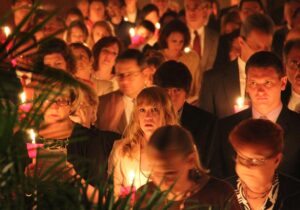Towards Better Protestant-Orthodox Dialogue
Hank Hanegraaff’s recent conversion to Orthodoxy has stirred up quite a reaction, most notably among Protestants. It is not surprising that Protestants would criticize Orthodoxy. However, what is dismaying is the poor logic employed in their critique of Orthodoxy. Below are some examples of the poor reasoning often found in Protestant critiques of Orthodoxy. The aim here is not to defend Mr. Hanegraaff, but rather to point out some clumsy attempts at anti-Orthodox apologia in hopes of promoting better Protestant-Orthodox dialogue.
1. Hasty Generalizations – Oftentimes general conclusions are made based on insufficient or biased evidence. A good example is this comment: “Oh, you Orthodox light candles! Roman Catholics light candles too. That means Orthodoxy is like Roman Catholicism.” She took one little act of devotion and expanded it into a whole religious system!
2. False Equivalence or Faulty Analogy — One mistake Protestants often make is equating Orthodoxy with Roman Catholicism, for example: “Orthodoxy is Roman Catholicism without the Pope.” Protestants seeing similarities between Orthodoxy and Roman Catholicism, assume both to have identical doctrines, so they apply the standard Protestant arguments against Roman Catholicism to Orthodoxy. There are differences in the way Orthodoxy does theology, approach worship, understands salvation in Christ, and understands the Virgin Mary, compared to Roman Catholicism. Arguments that apply to Roman Catholicism may not necessarily be appropriate for Orthodoxy.
3. External Expectations – Many Protestants complain: “Where’s the sermon? Why do we have to stand? Why does the priest have to go behind that wall of pictures? Why do they have incense and candles?” Behind the complaints that Orthodoxy is not like Protestantism, is the assumption that it ought to do things like Protestants. But why should Orthodoxy conform to Protestantism? What makes Protestantism the benchmark? Shouldn’t Scripture be the benchmark? Visiting an Orthodox church service is like visiting a foreign land. Protestant visitors should have the mindset of a tourist open to learning something new, and not expecting things to be like back home.
A more subtle form of the external expectations fallacy is for the apologist to compare Orthodoxy’s beliefs and practices with that of Protestantism. They will bring up things that will disconcert their Protestant audience like the veneration of icons, Holy Tradition, Mary as the Theotokos, theosis, etc. The unspoken assumption is that the benchmark for evaluating Orthodoxy is Protestantism. But shouldn’t Scripture be the benchmark for both Orthodoxy and Protestantism? Is it not possible that Orthodoxy has a better reading of Scripture? There needs to be a discussion about the biblical basis for both traditions.
Another unrealistic expectation is that Orthodox theology ought to have an elaborate articulation like the Reformed tradition’s Westminster Confession. This desire for theological precision reflects Protestantism’s roots in Medieval Scholasticism.
4. Critiques Based on Emotions – A Protestant visitor to an Orthodox service might complain about how the chanting sounds weird or that the smell of incense makes their nose itch. It’s okay to voice one’s personal discomfort but more important is an assessment based on Scripture. The Protestant visitor might ask himself: “What does the Bible say about sitting down in pews for Sunday worship, or giving a sermon at every Sunday service, or about the use of incense in worship?”
5. False Dichotomy/Excluded Middle – When it comes to Protestantism’s core doctrine sola fide (justification by faith alone), Protestant apologists frequently take the stance: “If you don’t believe in sola fide, then that means you believe in salvation by works like the Roman Catholics do.” On that basis, they then apply the standard Protestant polemic against Roman Catholicism to Orthodoxy. However, Orthodoxy’s understanding of salvation differs from both Roman Catholicism and Protestantism. For example, Orthodoxy believes faith without works is dead faith, and that our salvation in Christ demands synergy between God and humans. Yet Orthodox do not believe good works merit salvation in any way. The Bible presents salvation in a number of different ways. The Protestant tradition tends to restrict salvation almost exclusively to forensic justification. Besides justification, Orthodoxy teaches union with Christ, imitating Christ, the healing of the soul, enlightenment, our transformation into the likeness of Christ.
Historically, terms like “Christian” and “Christianity” were defined along the lines of Christology. Then in the 1500s being a Christian was fused with Luther’s sola fide and the terms underwent a distinctive Protestant re-definition. The premise here is that unless your church group holds to the doctrine of salvation “by grace alone through faith alone” you are not a true Christian and that you are part of a heretical sect. The problem with this Protestant dichotomy is Orthodoxy’s ancient and historic understanding of faith, works, and salvation, predates and differs significantly from both Roman Catholicism and Protestantism.
6. Loaded or Pejorative Terms – This is using words that are loaded with emotions. They can be scare words like “heresy,” “idolatry,” or “dead religion,” or comfort words like “common sense,” or feel good words like “powerful truths” or “bible-based.” Much of Orthodoxy will be foreign to Protestants so it is important that they define terms like: “dead worship” or “institutional religion” to their Orthodox friends and ask if they agree with their impression. The definition should allow for empirical verification and be applicable to both sides.
When Protestants refer to sola fide as a “fundamental belief,” they are using power words, words loaded with positive emotions. However, what may be fundamental for you may not be fundamental for the historic Church. A historical analysis of a doctrine’s importance and how widely it was embraced can help us determine whether it is a universally held dogma or a deviant, minority opinion.
On the reverse side, Protestants often have strong emotional reactions to words commonly used among Orthodox. They bristle at Orthodoxy’s claim to being the “true Church” and conclude that this is a sign of arrogance or it being a cult. Other words that may provoke strong reactions are: “synergy,” “Tradition,” “theosis,” “Eucharist,” etc. The key here is being aware of strong emotions that can derail Protestant-Orthodox dialogue. One can give voice to one’s emotion by saying: “I get very concerned or I feel alarmed when I hear Orthodox say this ‘word.’” Putting one’s feelings out on the table help clear the air contributing to friendly and frank Reformed-Orthodox dialogue.
Talking Past Each Other
7. Semantic equivalent fallacy – This frequently occurs when two parties understand the same term in quite different ways resulting in their talking past each other. The term sola scriptura has often been understood in more ways than one. Keith Mathison in The Shape of Sola Scriptura has done a tremendous service with the distinguishing between the classic Reformation sola scriptura which allows for creeds, church fathers, and reason to inform our reading of Scripture, and the later solo scriptura which eschews them. Many Evangelicals, not knowing classical Reformation theology, think they are defending sola scriptura when they are actually defending solo scriptura which emerged in the 1800s. Some Protestants will introduce the phrase “prima scriptura” (scripture first). While it sounds like a kinder and gentler version of sola scriptura, it can lead to considerable ambiguity and confusion. Unless it can be differentiated from the classic Protestant sola scriptura, it is best avoided.
The semantic equivalent fallacy often occurs when Protestants hear Orthodox Christians speak of Tradition and assume it refers to Roman Catholic practices like: indulgences, statues of Mary, Christmas trees, or rosaries. A similar problem occurs when Protestants read Jesus’ criticism of the tradition of the Jews in Matthew 15 and apply it to Tradition held by Orthodoxy. Just because the word “tradition” occurs in two different contexts does not necessarily mean they refer to the same thing. Sadly, many Protestants don’t understand Holy Scripture uses the word Tradition in several very different ways — or that Protestant bible translators often don’t make this clear.
Sometimes Protestant apologists will point out the Orthodox belief in deification (theosis) and mention that Mormons likewise believe in theosis. What we have here is the conflating of the semantic equivalent fallacy with the red herring fallacy. While they may both use the same word, the two groups have very different meanings for the word. In the red herring fallacy, one “wins” a debate or scores points by leading attention away from the argument to another topic.
Terminological Illiteracy — A related problem is Protestant ignorance of Orthodox terms. Some will give you a blank look if you say: “Eucharist,” “Liturgy,” “Creed,” or “Ecumenical Council.” Before a serious dialogue can begin, both sides must be aware of each other’s terminology and reference points. Thankfully, the recent influx of Protestant converts means that Orthodoxy has “bi-lingual” members who can present Orthodoxy knowledgably to Protestants.
8. Anachronism – This fallacy usually refers to an idea, event, or person being misplaced in time. One example is the assumption that sola fide and sola scriptura were part of the early Church, instead of Protestant doctrines that emerged in the 1500s. Another example is the assumption that the meaning of theological terms remains static over time. For example, the Protestant understanding of sola scriptura have shifted over time. Therefore, in a dialogue it is often important to mark whether one is using the original meaning or a later understanding of the term.
A related historical error is to assume that the Orthodox Church’s claim to be the same Church as the early Church means that there have been no change in its worship, structure, or theology, and that historical change would invalidate its claims. Here the outward forms are confused with internal meaning. For example, while the Liturgy underwent development in the early centuries the Church held fast to the real presence in the Eucharist. Orthodoxy has held steadfastly to this understanding, while much of Protestantism has jettisoned this fundamental belief.
Personal Attack
9. Focusing on moral failings is a form of ad hominem fallacy where one attacks the person, not their argument. A more subtle form is to infer shady motives or emotional disorder in someone’s conversion to Orthodoxy. Related to this is the poisoning the well fallacy. Here irrelevant adverse information about a target is preemptively presented to an audience for the purpose of discrediting anything they might say. These tactics detract from the important task of discussing beliefs and practices in a respectful manner, and for both sides to present evidence for their positions.
Mishandling Sources
10. Cherry picking Orthodox sources – In every religious tradition are nominal members who know very little about their faith. And, there are people who left the faith, became enmeshed in scandal, or tragically took their lives. Using them as sources or examples is not appropriate. It is better to focus on what the Protestant and Orthodox traditions teach than to focus on the dirty laundry.
11. Cherry picking the early Church Fathers – Oftentimes Protestant apologists will mention idiosyncratic opinions like Irenaeus of Lyons’ belief that Jesus lived to be 50, Epiphanius of Salamis ripping down the curtain with the image of Christ, or the Synod of Elvira with its supposedly iconoclastic ruling. Important to Orthodoxy is the patristic consensus. It is this consensus that helps us understand what constitutes the historic Christian Faith or capital “T” Tradition. For example, the Church Fathers universally affirmed the Trinity, the divinity of Christ, Mary as the Theotokos, the real presence of Christ’s body and blood in the Eucharist, and the Christian Faith as something “handed down” from the Apostles.
12. Proof texting the Church Fathers – Oftentimes a Protestant apologist will present a quote from an early Church Father that appears to support Protestantism’s doctrine of sola scriptura or sola fide. Many times they fail to give important information about the source like title, chapter and section number, or page number. This leaves the inquirer at a disadvantage unable to independently verify the citation. Oftentimes an examination of the citation will show that the passage was taken out of context or an idiosyncratic opinion of that one person.
Protestant Premises
13. Protestantism is Infallible – Oftentimes the apologist has the attitude that core Protestant doctrines like sola scriptura or sola fide must not be questioned. Furthermore, they insist these must be used as the starting point for dialogue. This inflexible, unquestioning attitude brings a chill to Reformed-Orthodox dialogue. Treating sola scriptura and sola fide as axioms or unquestioned premises can work within Protestant circles, but not in Protestant-Orthodox dialogue. In such dialogues, the starting point must be Scripture. The discussion of Scripture needs to be flexible, allowing for diverse approaches to reading Scripture. Doctrines like sola scriptura, sola fide, and sola gratia are all end points, that is, the result after studying Scripture. To impose axiomatic premises like sola scriptura is a form of rigging the game in favor of Protestantism. A subtle form of rigging the game takes place when the Protestant asks: “Where does it say that in the Bible?” The Orthodox believer needs to keep in mind that while much of what Orthodoxy comes from the Bible; a lot of it is based on oral Apostolic Tradition. In a Protestant-Orthodox dialogue it is important that the Orthodox Christians be knowledgeable about the Bible and the teachings of the Church.
14. Protestantism has no tradition – Many Protestants are unaware that they interpret the Bible within a particular theological tradition. Each and every religious group has a history, and this history gives the group a shared identity which informs the way they understand the Bible. A Presbyterian might hold to infant baptism while his Baptist counterpart would vehemently disagree insisting that the Bible teaches adult baptism by total immersion. W. Bradford Littlejohn’s The Mercersburg Theology and the Quest for Reformed Catholicity describes two competing understandings of the Lord’s Supper within the Reformed tradition. It is important that both sides be able to discuss the history of their respective beliefs and practices.
Last Words of Advice
The differences between Protestantism and Orthodoxy are not minor or trivial. This fact cannot be glossed over, but neither should it be exacerbated. We have much in common: the Bible as the divinely inspired and authoritative word of God, belief in Jesus Christ as fully God and fully man, his saving death on the Cross and his third day Resurrection, the Trinity, and Christ’s Second Coming. All these provide common ground for fruitful and mutually edifying discussions. Protestant-Orthodox dialogue will not be easy, but it can be deeply rewarding.
My advice to Protestant apologists is: “Do your homework. One common failing I’ve noticed in Protestant anti-Orthodox apologetics is they don’t do their homework. Another common failing is not being aware of how their anti-Catholic prejudices have shaped their theology. A third failing is not being aware that new apologias have emerged on the Orthodox side. This means that old arguments against Orthodoxy may no longer be valid. It is all the more imperative that Protestant apologists do their homework. If one does not have the time or inclination to do the homework, then one should maintain a respectful silence.”
Let us be mindful of Apostle Paul’s words:
Let your conversation be always full of grace, seasoned with salt, so that you may know how to answer everyone. (Colossians4:6)
Robert Arakaki
Resources
“Drake’s List of the Most Common Logical Fallacies”
“List of Fallacies” Wikipedia
Peter E. Gillquist. 1989. Becoming Orthodox. Rev. 1992.
Robert Letham. 2010. Through Western Eyes.
W. Bradford Littlejohn. 2009. The Mercersburg Theology and the Quest for Reformed Catholicity.
Robert Arakaki. 2011. “Book Review: The Shape of Sola Sctriptura.” OrthodoxBridge.
Keith A. Mathison. 2001. The Shape of Sola Scriptura.
James R. Payton. 2007. Light from the Christian East.
Kallistos (Timothy) Ware. 1963. The Orthodox Church. 2nd ed.










Recent Comments